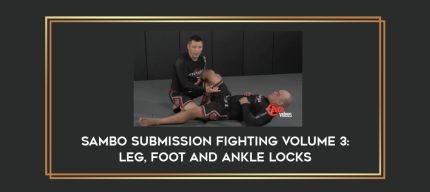Sin Moo Hapkido Level 2 Techniques
Course Description
Archive : Sin Moo Hapkido Level 2 Techniques Digital Download
Salepage : Sin Moo Hapkido Level 2 Techniques
Delivery : Online With Any Device
Sin Moo Hapkido Level 2 Techniques
Sin Moo Hapkido is a martial art that combines “hard” and “soft”
techniques. It is closely related to its parent art, Hapkido, though it
places more emphasis on meditative, philosophical, and Ki development
training. Hapkido is often translated as �the way of coordinating
power,� which places emphasis on the physical techniques that Hapkido is
often known for. The founder of Sin Moo Hapkido, Ji Han-Jae, explains
the meaning differently. Hap means bringing together, gathering, or
harmonizing. �Ki� is the energy or breath in the body that connects the
mind and the body, and “Do” is the process or way this happens. His
definition of Hapkido is, �The way of harmonizing the mind and body
through the utilization of ki.� Sin means “higher mind or higher
spirit,” and “Moo” means “martial art.” When translated in its entirety,
Sinmoo Hapkido means, �The way of using martial arts to harmonize the
mind and body to reach a higher more enlightened state of existence.�[1] Contents
1 History
2 The art
3 Techniques
3.1 Holds and Joint Locks
3.2 Throws, Re-Direction and Blocks
3.3 Kicks and Punches
3.4 Pressure Points and Energy Flow
3.5 Weapons
4 Ranks
5 Uniform
6 Meditation and Ki Breathing
7 Nine basic rules
8 Basic techniques to attain Green Belt
9 Basic techniques to attain Blue Belt
10 Basic techniques to attain Red Belt
11 Basic techniques to attain Brown Belt
12 Basic techniques to attain Black Belt
13 Sin Moo Hapkido Grandmasters (9th+ Dan)
14 External links
HistorySin Moo Hapkido was founded in 1983 in Seoul, South Korea by
Dojunim Ji, Han Jae (b. 1936) with the assistance of Merrill Jung and
other members of the Northern California Hapkido Association. The
curriculum was based off of Ji’s earlier hapkido programs that he
developed from his three teachers and own personal study. Ji, Han Jae
was an early student (Dan #14) of Choi, Young Sool, the founder of
Hapkiyusool, a forerunner of Hapkido, and also a student of teachers
known only as Master Lee and Grandma. Though formed in Seoul, the first
official school for Sin Moo hapkido was not opened until 1984 in Daly
City, California where Ji began teaching his new art. The artSin
Moo Hapkido incorporates a philosophy of non-violence, self improvement,
adaptability, and physical, emotional and spiritual balance, with the
basic Hapkido training. Additionally, Sin Moo Hapkido formalizes a
series of techniques, although at advanced levels students are expected
to synthesize their own work. The use of energy flows are also
emphasized in Sin Moo Hapkido. TechniquesSin Moo Hapkido uses
holds, joint locks, throws, re-direction, kicks, punches, blocks,
pressure points, weapons, and energy flow techniques. Holds and
Joint LocksHolds and joint locks are used primarily for control of an
aggressor. They are primarily defensive, but at more advanced levels can
be interpreted as attacks. At the 4th dan black belt there is also
taught 30 special attack techniques using variations and combinations of
basic locks. Throws, Re-Direction and BlocksThrows and
re-direction of an aggressor’s energy use an attacker’s momentum to
continue their own motion using the circular motion principle (Won) of
Hapkido. These techniques depend on the incoming energy of the attack to
determine their outcome; a soft or weak attack will require a small or
soft re-direction. A large or powerful attack will result in a
re-direction or throw that involves much more energy, translating to a
more devastating outcome upon the attacker. The blocks used in Sin Moo
Hapkido are usually also re-direction blocks, but some blocks are
intended to be used to stop an aggressor’s attack and because of this
some blocks are hard blocks. Also legs are used for blocking.
Kicks and PunchesSin Moo Hapkido uses a wide variety of strikes. Sin Moo
Hapkido incorporates 25 defensive kicks that are useful in “street
style” defensive situations that counter incoming attacks � out of the
25 two are specially only used to block kicks, but some of the other
kicks can be used the same way also. Many of the kicks are designed for
use in restricted spaces like hallways or crowds. After learning the
basic 25 the student then learns 7 spin kicks, followed by many special
kicks. Special kicks are harder to master but they need more room to be
used, and they include doublekicks, flyingkicks, from the ground done
kicks, jumpingkicks and combination kicks. Sin Moo Hapkido has numerous
striking techniques. Pressure Points and Energy FlowPressure
points are used in Hapkido to control the physical body, and to
manipulate the body’s Ki to stop, disarm and disable an attacker or heal
a patient. Sin Moo Hapkido uses 25 pressure points out of the body’s
over 600 pressure points. The pressure points are also referred to as
vital points. Sin Moo Hapkido has a special side called Revival
Techniques, which specializes on pressure point fighting and eastern
medicine. WeaponsSin Moo Hapkido weapon training consist the use
of short stick (Dan Bong), long stick (Jang Bong), the sword (Kum),
cane, handkerchief, long-belt/scarf, thrown weapons (knives, rocks,
etc…) and adapting everyday objects to use as weapons. Weapon training
is learned in the black belt stages, but knife defense techniques are
learned at Brown Belt.
RanksSin Moo Hapkido’s ranking system is somewhat similar to other
ranking systems. Gups (급, called also kups) are beginner
student stages and dans (단
are advanced student stages. Though Sin Moo Hapkido has had a number of
different revisions as far as rank structure, this is the current
organization used by Ji, Han Jae. [2] Belt Ranks: White Belt
Green Belt
Blue Belt
Red Belt
Brown Belt
Black Belts: 1st Dan: Black Belt
2nd Dan: Assistant
3rd Dan: Assistant Instructor
4th Dan: Instructor
5th Dan: Head Instructor
6th Dan: Master
7th Dan: Head Master
8th Dan: Junior Grandmaster
9th Dan: Grandmaster
10th Dan: Senior Grandmaster
Dojunim: Ji, Han Jae
UniformThere are many variations when it comes to uniform in Sinmoo
Hapkido as there was no official uniform for many years. Most European
schools used white uniforms with black trim, and most American schools
used plain white judo uniforms for the first 15 years or so. The
current official uniform is a grey colored dobak often with ties at the
bottoms (for leg weights), though many people chose to leave the legs
open. There is a World Sinmoo Hapkido logo on the left lapel and an oval
shaped Sinmoo Hapkido logo on the back. Meditation and Ki
BreathingSin Moo Hapkido has many meditation techniques. They are a
combination of Buddhist, Confucian, and Taoist exercises and primarily
focus on Ki development and opening the “mind’s eye.” Sin Moo Hapkido’s
first exercise is known as Danjon(Tanjun, Tanjon, Danjun) Breathing and
is similar to Chinese Qigong practices. Sin Moo Hapkido classes usually
start with danjon breathing and end with meditation. Nine basic
rulesSin Moo Hapkido’s basic rules are categorized into three groups to
make a total of 9 rules. The first three are associated with
Confucianism. The second are related to Buddhism. The last three rules
are related to Seon Buddhism and Taoism. These rules will help the Sin
Moo Hapkido practitioner to have a better and healthier life. Physical:
Basic techniques to attain Green Belt25 Basic Kicks
Basic Escapes
Basic 8 Hand Techniques
Clothing Grab Defense
Basic techniques to attain Blue BeltSpin Kicks
Punch Defense
Cross Hand Wrist Techniques
Behind and Body Grab Defense
Basic techniques to attain Red BeltKicking Styles
Kick Defense
Cross Hand on Top Wrist Techniques
Choke Defense
Basic techniques to attain Brown BeltKicking Styles
Knife Defense
Side by Side Wrist Technqiues
Sit Down/Lie Down Techniques
Basic techniques to attain Black BeltSpecial Kicking
Throw Defense
Basic Yudo Style Throws
Advanced 8 Wrist Techniques
More from Categories : Fighting






















